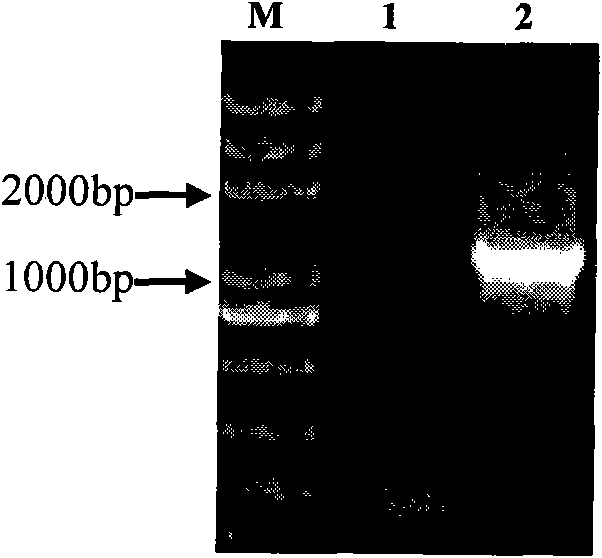Promoter specifically-expressed in rice embryo and application thereof
A technology of promoter and rice, applied in the field of genetic engineering, can solve the problem that there is not much research work on the separation of high-efficiency tissue-specific promoters, and achieve the effects of increasing yield and economic benefits, improving seed quality and wide application value.
- Summary
- Abstract
- Description
- Claims
- Application Information
AI Technical Summary
Problems solved by technology
Method used
Image
Examples
Embodiment 1
[0019] Example 1: Cloning of the promoter sequence OsESP1 specifically expressed on rice chromosome 1.
[0020] The promoter sequence of the gene on rice chromosome 1 was retrieved through the rice database and related gene information, named OsESP1. Genomic DNA was extracted from rice "Zhonghua 11" as a template, and OsESP1 was obtained by PCR using specific primers.
[0021] 1. Extraction of rice genomic DNA:
[0022] (1) Referring to the CTAB method, weigh 0.2 g of fresh tissue or a sample stored at -70°C, grind it fully in liquid nitrogen until it becomes powdery, and add liquid nitrogen slowly during the grinding to prevent the material from thawing.
[0023] (2) Quickly transfer the grinded tissue to a preheated (65°C) EP tube containing 600 μl of CTAB extract, incubate at 65°C for 15 minutes, and mix 2-3 times in between.
[0024] (3) Take out the centrifuge tube, cool to room temperature, and centrifuge at 10000rpm for 10min.
[0025] (4) Pipette the supernatant int...
Embodiment 2
[0041] Embodiment 2: the construction of OsESP1 expression vector ( figure 2 ).
[0042] 1. The commercialized expression vector pCambia1301 plasmid was digested with Hind III and Nco I, and the constitutive promoter CaMV35S before the vector reporter gene GUS was excised, and the transformed vector was named pCambia1301M.
[0043] The double enzyme digestion system is:
[0044] pCambia1301 plasmid 15μl
[0045] HindⅢ 2μl
[0046] NcoI 2μl
[0047] 1xM buffer 5μl
[0048] Add water to 50 μl, digest at 37°C for 3 hours.
[0049] 2. The pCambia1301M plasmid obtained after digestion with Xba1 and Pst1 was digested at 37°C for 3 hours. The double enzyme digestion system is:
[0050] pCambia1301M plasmid 15μl
[0051] Xba 12μl
[0052] Pst 12μl
[0053] 1xM buffer 5μl
[0054] Add water to 50μl
[0055] 3. Xba1 and Pst1 digest the promoter OsESP1 PCR product, and the double digestion system is the same as in Example 2.2.
[0056] 4. Use T for the two recovery fragment...
Embodiment 3
[0102] Example 3: The pCambia1301M::OsESP1 plant expression vector was transformed into Agrobacterium.
[0103] 1. Preparation of Agrobacterium competent cells.
[0104] (1) Pick a single colony (EHA105) and inoculate it into about 3ml of YEB liquid medium, and culture it at 28°C with shaking at 220rpm until OD 600 = 0.5.
[0105] (2) Pipette 1.5ml of bacterial solution into a centrifuge tube and place in ice bath for 10 minutes.
[0106] (3) Centrifuge at 5000rpm for 30S, discard the supernatant.
[0107] (4) Suspend the precipitate with 1.5ml of 0.5M NaCl and ice-bath for 20min.
[0108] (5) Centrifuge at 5000rpm for 30S, and discard the supernatant.
[0109] (6) Use 100μl 20mM CaCl per tube 2 Suspended, used for transformation, and stored at -70°C for future use.
[0110] 2. Direct transformation of DNA into Agrobacterium.
[0111] (1) Add 0.1-1 μg (5-10 μl) of pCambia1301M::OsESP1 expression vector plasmid DNA to 50 μl of Agrobacterium competent cells, and then ice-...
PUM
 Login to View More
Login to View More Abstract
Description
Claims
Application Information
 Login to View More
Login to View More - R&D
- Intellectual Property
- Life Sciences
- Materials
- Tech Scout
- Unparalleled Data Quality
- Higher Quality Content
- 60% Fewer Hallucinations
Browse by: Latest US Patents, China's latest patents, Technical Efficacy Thesaurus, Application Domain, Technology Topic, Popular Technical Reports.
© 2025 PatSnap. All rights reserved.Legal|Privacy policy|Modern Slavery Act Transparency Statement|Sitemap|About US| Contact US: help@patsnap.com



